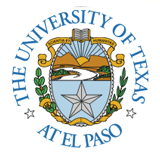I³: A Cyberinfrastructure and Communication-Based Model to Foster Innovation that Broadens Participation in STEM Fields through Inst. Integration
PROJECT OVERVIEW:
A Cyber-infrastructure and Communication-Based Model to Foster Innovation that Broadens Participation in STEM Fields through Institutional Integration brings together NSF/EHR awards from the ADVANCE, AGEP, CCLI, GK-12, LSAMP, REU, and S-STEM programs, as well as other work, around the I³ integrative theme(s) of broadening participation and the integration of research and education.
A Cyber-infrastructure and Communication-Based Model to Foster Innovation that Broadens Participation in STEM Fields through Institutional Integration will transcend departmental silos and hierarchical administrative structures to transform the University of Texas at El Paso (UTEP) into an institution in which faculty are committed to sharing resources, collaboration is supported through recognition and rewards, and effective practices emanating from NSF-funded awards at UTEP focused on broadening participation are extended across the university. The discussions among diverse faculty members and administrators facilitated by the model are expected to stimulate innovation in preparation of students for undergraduate and graduate education in STEM areas and result in proactive strategies that provide effective avenues for sustainability. The unique mechanisms for obtaining this institutional collaborative culture are the development of the Cyber-Infrastructure (CI) and communication structures (Provost-led STEM Council and Special Interest Groups) that can drive innovation and extend and sustain the impact of efficacious broadening participation initiatives. In the context of this proposal, CI refers to the technical infrastructure, organizational practices, and social interactions that support data and resource sharing, as well as efforts that cross boundaries within or outside the organization.
The anchor for this I³ project is the NSF CREST-funded CYBER-ShARE Center, which has expertise in CI and cross-disciplinary collaborations. The CYBER-ShARE Center (using Cyber-Infrastructure to Share resources to Advance Research and Education) brings the experiences and base to serve as the foundation for this effort, which will integrate its work and initially that of projects that have demonstrated effectiveness in broadening participation at all levels of the academic continuum.
The CI will be developed to support the project in the following ways: 1) semantically annotated websites; 2) accessible databases that can be used to inform faculty, staff, and administrators on matters relevant to research projects and data relevant to broadening participation; 3) Web portal that supports networking, collaborations, and shared activities centered on Special Interest Groups (SIGs) on broadening participation; and 4) intra-campus communications facilitated by the Provost-Led STEM (ProSTEM) Council. Initially, NSF-funded projects contribute data to the CI and other UTEP faculty members make use of this information in developing their own future endeavors. Over time, information from efforts funded by sources other than NSF provide information to the CI as collaboration among faculty and administrators becomes the new norm in this culture of collaboration. This institutional transformation involves defining practices, procedures, and policies on campus that support linkages among projects, cross-fertilization of practices, and identification of new research directions. By engaging faculty across disciplines, projects benefit from discussions that analyze common threads from multiple perspectives. The CI will improve the efficacy of the University’s programmatic and evaluation frameworks for monitoring activities and measuring student progress.
This I³ endeavor allows UTEP to take a more proactive approach to creating a culture of collaboration by establishing the CI and communication structures to enable the study and understanding of professional organizational relationships. The integration of STEM interests at UTEP provides value-added in a minimum of three organizational CI domains. It is expected that: 1) the number and extent of reciprocal relationships among STEM interest groups will be much larger than the number and extent of non-reciprocal relationships (degree of hierarchy); 2) the lateral, peer-to-peer networks will see heavy interaction and activity, indicating dispersed global activity rather than activity with a few focal points in the local community (degree of centralization); and 3) there will be fewer hierarchical levels for access to problem solutions, and information for solving problems, than a traditional STEM educational and research enterprise structure (hierarchical levels in the emergent portal).
Dates:
Start: September 15, 2010End: August 31, 2015
Project Members:
Institution:
University of Texas at El PasoProject Website:
CYBER-ShARE Center of Excellence


